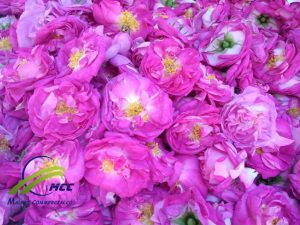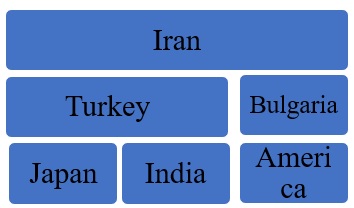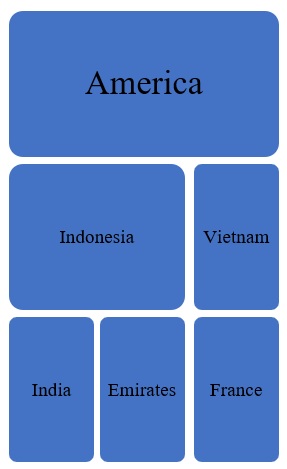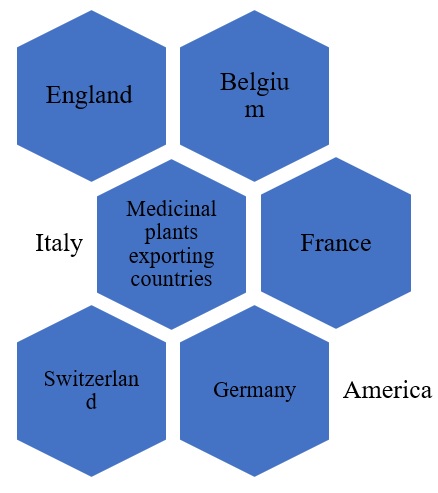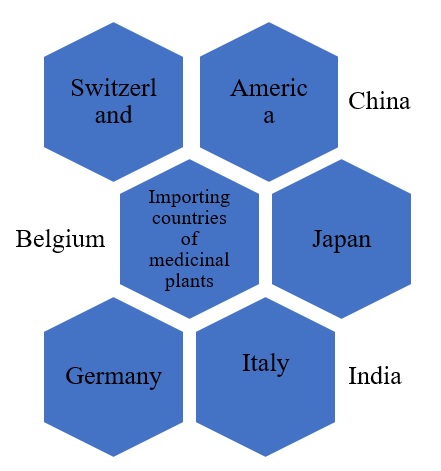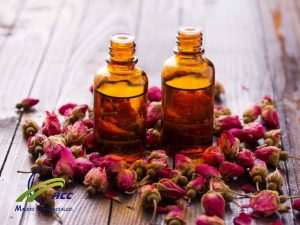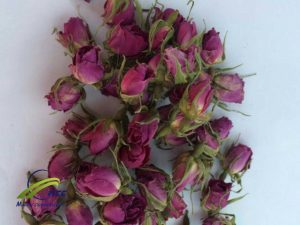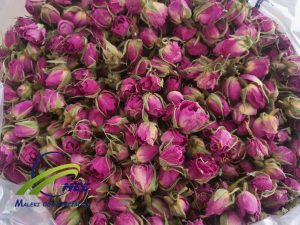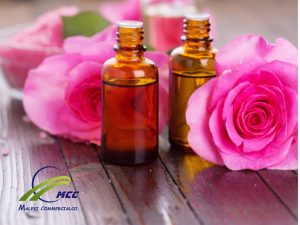Wholesale Dried Damask Rose
Maleki Trading Company is one of the best wholesalers of dried Damask Rose, suppliers and exporters of dried Damask Rose in Iran, as well as the main producer and Wholesale Organic Dried Rose Hip.
The Damask Rose (Rosa Damascena Mill), belongs to the rosaceae family, and is a highly valuable medicinal plant widely used in the pharmaceutical industry, food industry, and cosmetic-hygiene industries.
The Damask Rose Essential Oil (Rose Oil) is one of the most expensive and rarest aromatic essential oils, produced from the fresh Damask Rose.
History of medicinal plants
The Egyptians and the Chinese were among the first human civilizations to use plants as medicine for treating diseases over 27 centuries before Christ.
The ancient Egyptians left behind papyri, which indicate their use of medicinal plants.
Papyri are papers used by ancient Egyptians, also known as woven papers, and were among the significant commercial goods of ancient Egypt. This plant was discovered by the Egyptians around 2900 years before Christ.
Characteristics of the Papyrus Plant
The papyrus plant is aquatic and semi-grassy, growing to a height of 4 to 5 m. Its stems are sturdy, triangular, and green, reaching a height of 1 to 2 m. These reed-like stems arise from thick, woody rhizomes that contain a white pith. The papyrus plant belongs to the Cyperus family, also known as woven paper.
By developing transformation industries from this plant in the lush and fertile fields of the village of Al-Qaramous in Egypt, this plant has become a tourist attraction in Egypt.
Local Egyptian artists have created hieroglyphic, Arabic, and ancient designs on papyrus paper, selling them to tourists and generating a source of revenue for Egyptian tourism.
Products derived from the papyrus plant
– Plant paper
– Fabric
– Sandals
– Baskets
– Ropes
– Papyrus fragrance notes
The school of herbal medicine was founded by Theophrastus, a student of Aristotle, who is considered the father of botany. Aristotle referred to him as the “divine speaker,” and he described more than five hundred different plants. His research significantly contributed to the science of botany and the development of traditional medicine, paving the way for extensive future research into the medical and therapeutic properties of plants.
Avicenna (Ibn Sina) also elaborated on medicinal plants and their benefits in his book “The Canon of Medicine.”
Furthermore, Ibn al-Baytar (Zia-Aldin Abu Muhammad Abdullah Ahmad ibn Muhammad Maleki) was a renowned Spanish (ancient Andalusian) botanist and pharmacologist who made significant contributions to the field of botany. He traveled to various cities to learn botanical sciences. Among his most famous works is the “Risalah fi al-Agziyah and Al-Adwiyah”, in which he categorized each plant according to the disease it could treat.
The oldest known written record of using medicinal plants for treatment is a 5000-year-old Sumerian clay tablet from Nagpur, India.
Importance of cultivating Damask Rose
Due to its medicinal and cosmetic-hygienic properties, the Damask Rose has a high supply and demand in the medicinal plant trade market.
Exploiting Damask Rose cultivation fields not only creates jobs in agriculture, packaging, transportation, warehousing, and processing sectors in the cosmetic-hygienic, pharmaceutical, and essential oil extraction industries but also enhances the branding of Iranian products globally.
Iranians were among the first to discover the properties of this plant. By the 7th century AD, Iranians were able to process the petals of this plant to produce rosewater. In the 8th century AD, rosewater was an exclusive product of Iran exported to India and China.
The methods of rosewater and essential oil extraction were transferred from Iran to European countries. Currently, Spain, Turkey, Bulgaria, Switzerland, India, the United States, Vietnam, China, France, and Ukraine are Manufacturers of Damask Rose Essential Oil (Rose Oil).
In 2024, the area under Damask Rose cultivation was 31,000 ha, with an estimated harvest of 68,000 tons of Damask Roses.
Geographic distribution
Global Distribution
The Damask Rose is cultivated in Iran, Turkey, Bulgaria, India, Japan, the United Kingdom, Switzerland, and many other parts of the world.
Distribution in Iran
This plant is cultivated in Shiraz, Kashan, Tabriz, Kerman, Isfahan, and Yazd.
Exporting countries of Rose Essential oil (Rose Oil)
Importing countries of Rose Essential oil (Rose Oil)
Export statistics of medicinal plants in 2023
Import statistics of medicinal plants in 2023
The import of medicinal plants grew by 1.6% in 2023, but exports decreased by 3.5%, reducing the trade surplus from 174 billion euros to 158 billion euros.
In the same year, Germany was the largest exporter of medicinal plant products to non-EU countries.
Botanical Characteristics
The Damask Rose is a shrub that grows up to 2 m in height. Its stems are equipped with sturdy hook-like thorns, sometimes intermixed with glandular, hair-like bristles. The leaflets range from 2 to 6 cm in length, typically numbering 5 to 7 per compound leaf, and are ovate to ovate-rectangular in shape with simple serrated edges. The upper surface of the leaflets is glabrous, while the underside is somewhat pubescent. The petioles are thorny.
The flowers appear from May to June, blooming once a year, although some varieties bloom twice a year in spring and autumn.
The petals are red, pink, or white. The sepals turn backward and shed during flowering, covered on the dorsal side with glandular hair-like bristles. The flower buds are also covered with glandular hair-like bristles. The fruit measures 2.5 cm in length, and is obovate, hairy, and red. It contains multiple achenes surrounded by a fleshy ovary, with the bright red fruit enclosing achenes within its berry-like structure.
The Damask Rose flowers contain essential oil, and the yield varies depending on cultivation method, location, soil type, irrigation method, fertilization, and plant variety, ranging from 0.01% to 0.03%.
Ecological requirements for cultivation
-The cultivation of the Iranian Damask Rose in arid and semi-arid regions is more effective compared to other geographical areas, yielding flowers with higher essential oil content.
– This plant is drought-resistant. The optimal times for watering are during the budding and flowering stages.
– The climate of the cultivation area significantly affects the timing and frequency of irrigation.
– The ideal soil pH for this plant ranges from 6.5 to 7.
– The best soil is sandy-clay, with a light texture and good drainage.
– This plant thrives in soils rich in minerals and organic matter. Heavy soils that cause waterlogging are not recommended, as excessive water can lead to fungal diseases.
– The most crucial period for fertilization is between the budding and flowering stages, during which the plant requires iron, phosphorus, nitrogen, and potassium.
– Nitrogen and potassium significantly influence essential oil yield, flower weight, number, and diameter. Leaf mold and manure aid in the plant’s growth, and decomposed leaves are a suitable nutrient source.
– This plant is photophilic and needs 6 to 8 hours of indirect sunlight. Adequate light is one of the critical factors for growth and essential oil yield. (Different Damask Rose varieties have varying light requirements.)
– Direct sunlight is not necessary; excessive direct sunlight reduces the moisture around the plant, adversely affecting growth and essential oil yield.
– Cold, dry winds reduce the quality and quantity of the essential oil, while hot, dry winds damage the plant.
– Altitude affects the quantity and quality of the plant’s flowering. Higher elevations and northern slopes increase essential oil yield.
– Cultivating this plant in tropical regions with an average temperature of 38°C is not economically viable, as high temperatures negatively impact quality, quantity, and growth.
– The suitable average temperature for growth is 26°C during the growth period. A diurnal temperature difference of 3 to 4°C is necessary for bud formation. (Frost inhibits budding.) An average temperature of 15 to 20°C is needed for budding.
Damask Rose propagation
This plant can be propagated through both sexual and asexual (vegetative) methods.
Sexual propagation
Sexual propagation is achieved through seeds, which are produced in the ovary after pollination. Once the seeds mature, they should be collected.
This method is not suitable or economical for commercial cultivation of Damask Rose and is generally used for research purposes.
In sexual propagation, after harvesting the Damask Rose fruits, the fruits are dried and screened. The seeds are then treated through methods such as chemical or mechanical scarification and stored at 2 to 4°C for 2 to 3 months to enhance germination.
Seeds are sown in early autumn and sprout in early spring after one year. The seedlings can be transplanted to the main field in early autumn.
Vegetative propagation of Damask Rose
Vegetative propagation refers to the growth and development of plants through fragmentation and regrowth of specific vegetative parts.
This approach occurs through meristem tissue, found in stems, roots, and leaves. Meristem tissue consists of actively dividing cells and undifferentiated cells that give rise to other tissues.
In this method, cell division occurs without chromosomal reduction, ensuring that the propagated plant retains the genetic information of the parent plant.
Methods of vegetative propagation
- Cuttings
In late summer and autumn, Damask Rose can be propagated using woody and semi-woody cuttings.
Key point: Woody cuttings have the highest rooting potential for propagating Damask Rose.
Cutting definition
– A cutting is a part of the leaf, root, or branch separated from the parent plant and placed under favorable conditions to the root.
Types of cuttings
- Woody cuttings
Woody cuttings are propagated from the branches of the mother plant. Upon separation from the parent branch, these cuttings are placed in an appropriate environment conducive to root development. Following successful rooting, they are subsequently transferred to the primary nursery. These cuttings are characterized by their rigidity and hardness, typically sourced from the mature and lignified branches of the plant.
The process of obtaining woody cuttings is conducted during the winter or autumn seasons when the plant is devoid of leaves. If cuttings are taken prematurely, the rooting process will be inhibited due to the dormancy of the buds.
- Semi-woody cuttings: Semi-hard and semi-mature cuttings can be taken at any time of the year but are best harvested in late spring when environmental conditions favor rooting.
- Herbaceous cuttings: Taken from young, actively growing shoots, these are considered softwood cuttings.
Damask Rose cutting method
– Use woody and semi-woody cuttings.
– Woody cuttings should be 10 to 15 cm long, and semi-woody cuttings should be 10 to 12 cm long.
– Select healthy, pest-free stems for cuttings.
– Place cuttings in the soil such that leaves remain above the soil.
– Sterilize cuttings before planting.
– Plant cuttings in a mixture of sand and peat moss (two parts sand, one part peat moss) and cover with plastic.
– Water cuttings regularly until they root.
-
Suckers
Suckers are one of the simplest methods for propagating this plant. Suckers are shoots that grow from the healthy roots of the plant.
– Each mature mother plant (from the third year of cultivation onward) produces 20 to 60 suckers.
– Suckers are separated from the mother plant between November and early March and planted in the main field.
Key points
– Avoid damaging the mother plant when separating suckers.
– Choose healthy, vertical suckers.
– Do not select very young suckers.
-
Grafting
Grafting is another method of asexual propagation for Damask Rose, suitable from early September to late October.
– Select a flowering or budding branch and separate it from the bush.
– Then, use a knife to remove the bark below the bud, extending the cut to 15 mm above the bud.
– Remove leaves from the scion, leaving 1 to 2 cm of petioles.
– Create a T-shaped cut on the rootstock with a knife and insert the scion into the slit.
– Ensure the bud and petiole remain outside the slit, then wrap the grafting site with tape to secure the scion to the rootstock.
– Perform grafting quickly to prevent drying of the cut surfaces. If the petiole separates easily from the scion after a few weeks, the grafting is successful.
– Biochemical interactions between the scion and rootstock are essential for successful grafting, necessitating compatibility between them.
-
Layering
– In this method, long and soft branches are buried in the soil while still attached to the mother plant. Once the branches develop roots, they can be planted separately.
-
Tissue culture
Tissue culture is a modern plant propagation method using advanced technology. It involves the cultivation of plant cells, tissues, and organs under completely sterile and controlled conditions in a laboratory. This method is used for commercial production or research and produces new plants from plant tissues.
Plant organs are formulated in special nutrient media, and a plant can be produced from a single cell.
– Tissue culture of Damask Rose results in plants resistant to pests and diseases and increases rose production, although it is a costly method.
Pests and diseases
– Powdery mildew (Sphaerotheca Pannosa var. Rosae)
– Gray mold (Botrytis Cinerea)
– Black spot (Diprocarpon Rosae)
– Rose Rust (Phragmidium Sp)
– Downy mildew (Peronospora Sparsa)
– Verticillium wilt (Verticilium Albo-Atrum)
– Shoot borer beetle
– Green bud borer
– Aphids
– Thrips
Damask Rose Essential Oil (Rose Oil)
Damask Rose Essential Oil (Rose Oil) is an aromatic oil extracted from fresh rose petals using distillation equipment.
-
First Oil
– The initial distillation takes about 1 to 1.5 hours and produces 25 to 30 g of green or First oil.
– This oil has a relatively mild fragrance but is more stable and has a longer shelf life.
– It is produced from the distillation of fresh flowers and appears as a greenish-yellow layer floating on the surface of the rose water.
– First oil has a lower solubility in water and mainly consists of saturated hydrocarbons, solidifying upon cooling.
-
Second Oil
– To produce the Second oil, the rose water obtained from the first distillation is heated again.
– The distillation for the second oil occurs in a separate boiler where the rose water is heated, and the resulting steam is directed to the essential oil separator.
– This process extracts the essential oil, and the remaining liquid is reintroduced into the distillation cycle until all the oil is separated.
– This step takes 1 to 1.5 hours, producing a yellow Second oil, which is highly aromatic but has a shorter shelf life than the First oil.
– The second oil is more fragrant and solidifies when cooled.
-
Liquid Gold
– The rarest and most valuable type of rose essential oil is Liquid Gold, obtained by combining the first and second oils. It is widely used in cosmetics, perfumery, pharmaceuticals, and food industries.
– Approximately one liter of Absolute oil, known as “Liquid Gold,” is produced from three tons of rose petals, and it has a very strong fragrance.
-
Rose Concrete
– Rose petals are extracted with solvents like hexane and petroleum. After separating the residue, the solvent is evaporated, yielding an orange-red waxy substance.
– Concrete is semi-solid but becomes liquid when heated and has a mild aroma.
-
Absolute Rose Oil
– The produced concrete is dissolved in ethanol, and after the waxy compounds settle, the ethanol is evaporated at low temperature and pressure, resulting in Absolute rose oil.
– About 2.5 kg of Absolute oil is produced from 3 tons of freshly picked rose petals.
Composition and active ingredients of Rosa Damask Essential Oil (Rose Oil)
| α-Pinene |
| β-Pinene |
| β-Myrcene |
| α-Terpineol |
| Sabinene |
| Dl-Limonene |
| Ocimene |
| Terpineol |
| Nerol |
| β-Citronellol |
| Linalool L |
| Nerol |
| β-Citronellol |
| Benzeneethanol |
| Geraniol |
| Methyl Geranate |
| Eugenol |
| β-Bourbonene |
| β-Elemene |
| β-Selinene |
| β-Cubebene |
| Trans-Caryophllene |
| 9-Nonadecene |
| α-Farnesene |
| α-Bulnesene |
| Delta-Cadinene |
| Tricosane |
| Eicosane |
| Hexadecane |
| Z-9-Nonadecene |
| Heptacosane |
| (9Z)- Tricosene |
| Octadecane |
| Nonadecane |
| 5-Nonadecen-10 |
| 5-Eicosene,(E)-Eicosane |
Manufacturer of organic dried buds and petals
Maleki Commercial is a Manufacturer of organic Damask Rose in Iran, with extensive fields dedicated to the cultivation of this plant in the south of Shiraz.
The flowers, after being harvested in the morning, are transported by specialized trucks to the workshop for shade drying. After drying, they are stored in cool, dark, and moisture-free environments in warehouses near the cultivation fields.
For wholesale purchases of organic dried Damask Rose, please contact us via WhatsApp, email, or Skype.
Supplier of Dried Damask Rose Buds
Maleki Commercial supplies the highest quality organic Damask Rose with high fragrance, packaged in standard cartons. For wholesale purchases of dried Damask Rosebuds, please get in touch with us.
Bulk And Wholesale of Organic Dried Damask Rose and Petals
Maleki Commercial produces Damask Rose buds and petals that meet global GACP standards. By adhering to these standards, we prevent environmental contamination of medicinal plants, increase their active medicinal compounds, and implement standardized harvesting and processing methods.
For wholesale purchases of Damask Rose buds and petals, please contact us via WhatsApp.
Price of Dried Damask Rose Buds and Petals
If you need organic Damask Rosebuds and petals at competitive prices and of the highest production quality, please contact us. Purchasing from us guarantees 100% satisfaction.
Exporter of Organic Dried Damask Rose
Maleki Commercial exports dried Damask Rose buds and petals to countries such as Germany, UAE, France, Pakistan, and India. For purchasing export products, please contact us.
Supplier, Manufacturer, and wholesaler of organic damask rose essential oil (rose oil)
Maleki Commercial has revolutionized the production of pure and organic Damask Rose Essential Oil (Rose Oil) (Rose Oil) with citronellol content exceeding 50%, using the most advanced distillation equipment and innovative cultivation methods.
Our essential oils are completely pure, and all perfume manufacturing brands, cosmetic and pharmaceutical industries purchasing from us are guaranteed quality.
Supplier of pure organic Damask Rose Essential Oil (Rose Oil)
If you require pure and unique Damask Rose Essential Oil (Rose Oil) different from those available in the market, you will feel the difference by purchasing from us.
Bulk And Wholesale of pure organic Damask Rose Essential Oil (Rose Oil)
Maleki Commercial is a wholesale supplier of Damask Rose Essential Oil (Rose Oil) with exclusive distillation methods and ten years of export experience to countries such as Indonesia, Germany, France, India, and Vietnam. Our decade-long export history testifies to the quality of our services and products.
Price of Pure Damask Rose Essential Oil (Rose Oil)
At Maleki Commercial, we offer various types of essential oils—Type I, Type II, and Complete—with high active compound percentages and export-quality standards. These are available for all research centers, perfume factories, and the cosmetic and food industries. Contact us to receive the price list of Damask Rose Essential Oil (Rose Oil) in different quality and export grades.
Chemical composition of Rose Essential Oil (Rose Oil)
| α-Pinene |
| β-Pinene |
| β-Myrcene |
| β-Citronellol |
| α-Terpineol |
| Sabinene |
| Ocimene |
| Dl-Limonene |
| Linalool L |
| 4-Terpineol |
| Sabinene |
| Benzeneethanol |
| Phenethyl Alcohol |
| Nerol |
| Geraniol |
| Eugenol |
| Menthyl Geranate |
| Z-Citral |
| Eugenol |
| Geranic Acid |
| Geranyl Acetate |
| Rose Oxide |
| α-Guaiene |
| α-Humulene |
| β-Elemene |
| β-Bourbonene |
| Menthly Eugenol |
| Phenethyl 2-Methylbutyrate |
| Germacrene-D |
| Aciphyllene |
| β-Selinene |
| Β-Cubebene |
| α-Bulnesene |
| α-Farnesene |
| Delta-Cadinene |
| Pentadecane |
| Hexadecane |

